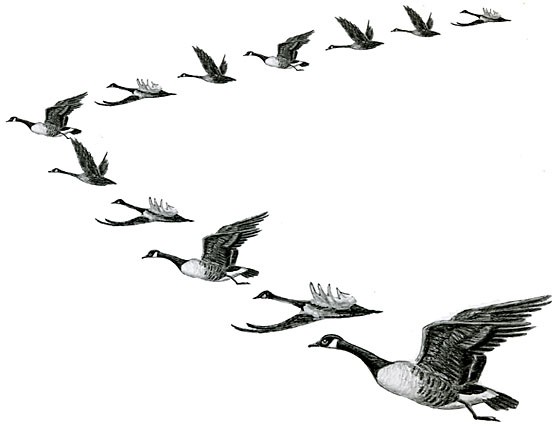It’s a familiar and awe-inspiring sight: long lines of geese gracefully carving their way across the autumn sky in a distinctive V formation. This iconic image of Canada Geese in flight is recognizable even to those who aren’t avid bird watchers. You might have pondered this yourself, and if you have, you’re not alone in wondering: why do geese fly in this stereotypical V-formation?
 Geese Formation
Geese Formation
The truth is, this is a question that has intrigued scientists and nature enthusiasts alike for years. While it might seem like a simple observation, the reasons behind this avian behavior are rooted in fascinating physics and social dynamics. The most widely accepted explanation for why geese adopt the V formation centers around energy conservation.
Imagine you’re flapping your arms in water. When you push down, you create an upward splash around you. Geese, with their powerful wings, do something similar in the air. As the lead goose flaps its wings, it displaces air, creating an updraft, or an upward column of air, behind it. This updraft essentially makes it easier for the bird flying directly behind to fly, providing a bit of a ‘lift’.
Now, you might think, wouldn’t it be even more efficient to fly directly behind the lead bird in a straight line? Surprisingly, the answer is no. The most beneficial updraft isn’t directly behind the bird but slightly off to the side, near the wingtips. This is due to wingtip vortices – rotating masses of air that spin off the wingtips. By positioning themselves just outside and behind the bird in front, geese can take advantage of this upward lift created by the wingtip vortex of the bird ahead. This optimal positioning results in the characteristic V shape, as each bird seeks to maximize the updraft from the bird in front while avoiding the direct wake. Furthermore, consider the less aerodynamic aspects of goose anatomy – flying directly behind another goose might not be the most pleasant experience for reasons beyond just airflow!
The energy savings achieved through V formation flight are significant. Studies estimate that geese flying in formation can conserve as much as 70% of the energy they would expend flying solo. This is a crucial advantage, especially during long migratory journeys that can span thousands of miles.
But who takes on the arduous task of leading the formation, constantly working harder to create that updraft for others? Geese are highly organized and cooperative creatures. The lead position is not a permanent assignment. The lead goose, bearing the brunt of the aerodynamic resistance, will eventually tire. When this happens, it will drop back into the formation, and another goose will take its place at the front. This rotation of leadership ensures that no single bird is excessively burdened, and the flock can maintain its energy-efficient formation over long distances.
Researchers have even used technology to study this phenomenon. In one study, scientists fitted pelicans (another bird species known for formation flight) with heart monitors. They discovered that the lead pelican had a significantly higher heart rate than the birds flying behind. However, when the lead pelican rotated back into the flock, its heart rate decreased, while the heart rate of the new leader increased. This provided direct physiological evidence of the energetic demands of the lead position and the benefits of formation flying for the following birds. The study also highlighted the efficiency of formation flight in reducing exertion for the majority of the flock.
If flying in formation is so advantageous, why don’t all migrating birds, especially smaller songbirds, adopt this strategy? The answer lies in the size and wing power of the birds. Smaller birds with smaller wings simply don’t generate a strong enough updraft to significantly benefit trailing birds. The aerodynamic advantage of V formation flight is most pronounced for larger, heavier birds like geese and pelicans, which have the wing power to create substantial updrafts. While songbirds could certainly use any advantage during their migrations, the V formation simply doesn’t offer them a significant enough benefit to warrant the complex coordination required. It’s a testament to the remarkable adaptations of geese that they have evolved to harness the power of cooperative flight, turning a long and arduous journey into a more efficient and sustainable endeavor.
